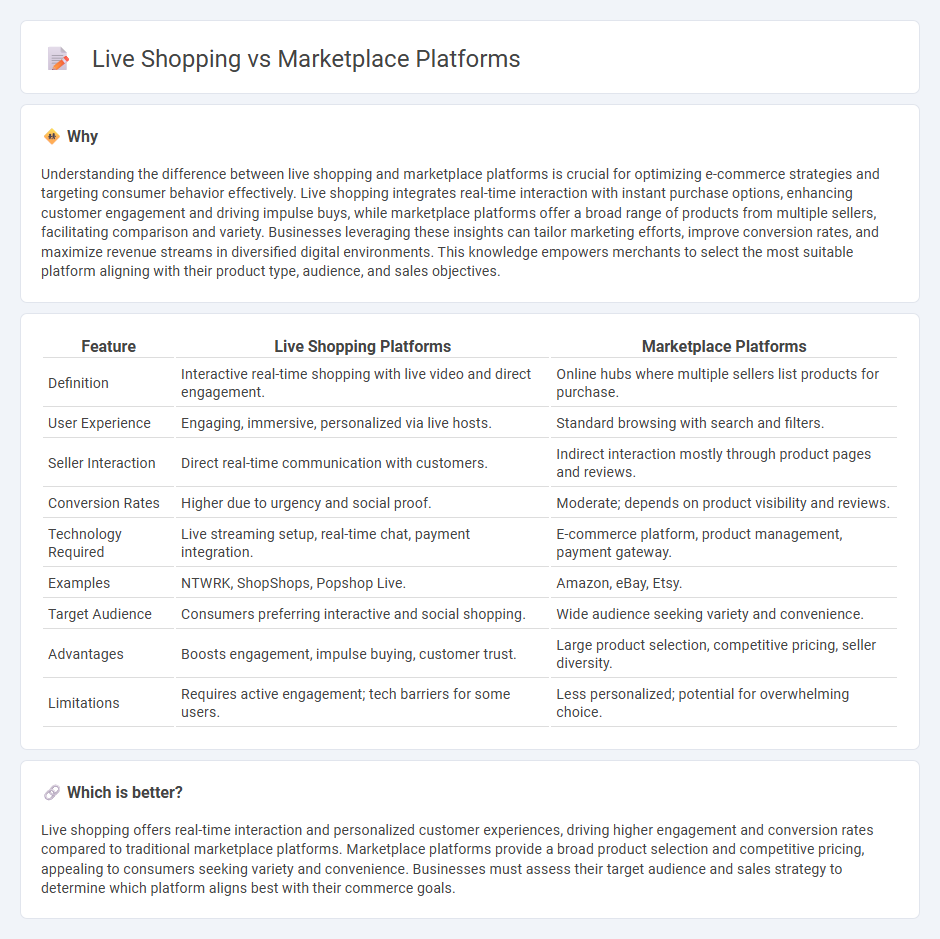
Live shopping platforms combine real-time video interaction with instant purchasing, creating an immersive and engaging consumer experience that boosts conversion rates and customer loyalty. Marketplace platforms aggregate diverse sellers and products into a centralized online space, offering extensive variety and competitive pricing but often lacking personalized interaction. Explore how these commerce models transform buyer engagement and sales strategies to enhance your business growth.
Why it is important
Understanding the difference between live shopping and marketplace platforms is crucial for optimizing e-commerce strategies and targeting consumer behavior effectively. Live shopping integrates real-time interaction with instant purchase options, enhancing customer engagement and driving impulse buys, while marketplace platforms offer a broad range of products from multiple sellers, facilitating comparison and variety. Businesses leveraging these insights can tailor marketing efforts, improve conversion rates, and maximize revenue streams in diversified digital environments. This knowledge empowers merchants to select the most suitable platform aligning with their product type, audience, and sales objectives.
Comparison Table
| Feature | Live Shopping Platforms | Marketplace Platforms |
|---|---|---|
| Definition | Interactive real-time shopping with live video and direct engagement. | Online hubs where multiple sellers list products for purchase. |
| User Experience | Engaging, immersive, personalized via live hosts. | Standard browsing with search and filters. |
| Seller Interaction | Direct real-time communication with customers. | Indirect interaction mostly through product pages and reviews. |
| Conversion Rates | Higher due to urgency and social proof. | Moderate; depends on product visibility and reviews. |
| Technology Required | Live streaming setup, real-time chat, payment integration. | E-commerce platform, product management, payment gateway. |
| Examples | NTWRK, ShopShops, Popshop Live. | Amazon, eBay, Etsy. |
| Target Audience | Consumers preferring interactive and social shopping. | Wide audience seeking variety and convenience. |
| Advantages | Boosts engagement, impulse buying, customer trust. | Large product selection, competitive pricing, seller diversity. |
| Limitations | Requires active engagement; tech barriers for some users. | Less personalized; potential for overwhelming choice. |
Which is better?
Live shopping offers real-time interaction and personalized customer experiences, driving higher engagement and conversion rates compared to traditional marketplace platforms. Marketplace platforms provide a broad product selection and competitive pricing, appealing to consumers seeking variety and convenience. Businesses must assess their target audience and sales strategy to determine which platform aligns best with their commerce goals.
Connection
Live shopping integrates real-time video streaming with e-commerce, enabling consumers to interact directly with sellers while browsing products on marketplace platforms. These platforms leverage live shopping to enhance user engagement, increase conversion rates, and provide personalized shopping experiences through instant feedback and demonstrations. The synergy between live shopping and marketplace platforms drives higher sales, fosters brand loyalty, and transforms traditional online commerce into immersive, social experiences.
Key Terms
Transaction Models
Marketplace platforms operate primarily on a commission-based transaction model, allowing multiple sellers to list products and facilitating direct purchases by consumers. Live shopping integrates real-time interaction and immediate purchasing opportunities, often blending fixed pricing with flash sales and exclusive discounts to drive impulse buying. Explore how each model enhances consumer engagement and revenue strategies further.
Real-time Engagement
Marketplace platforms offer extensive product selections with static listings, limiting real-time customer interaction compared to live shopping, which enables dynamic communication and instant feedback during broadcasts. Live shopping leverages interactive features such as live chat, polls, and influencer-hosted sessions to create immersive buying experiences that drive higher conversion rates and customer loyalty. Explore how integrating live shopping into your sales strategy can revolutionize real-time engagement and boost revenue.
Product Discovery
Marketplace platforms aggregate extensive product listings enabling broad product discovery through search filters and user reviews. Live shopping enhances product discovery by offering real-time demonstrations, interactive Q&A, and influencer engagement, driving higher customer trust and immediate purchase decisions. Explore how these strategies can boost your product visibility and conversion rates.
Source and External Links
Best Marketplace Platforms - Marketplace platforms are software technologies that connect sellers and buyers on a single platform, enabling transactions and managing payments usually on a commission basis, ideal for businesses seeking to scale with multiple sellers and products without owning inventory.
Best Marketplace Software to Build a Multi-Vendor Marketplace (2025) - Marketplace software like Arcadier and Marketplacer provide scalable, cloud-based solutions enabling enterprises to launch and manage multi-vendor marketplaces with features such as vendor management, payment processing, and order tracking, typically with custom pricing and some developer support required.
Top 20 ecommerce marketplaces in the world in 2025 - Leading global marketplaces such as Amazon, eBay, Rakuten, Shopee, and AliExpress dominate with hundreds of millions of monthly visitors, broad product categories, and regional or global reach, serving as key platforms for sellers targeting large online customer bases worldwide.
 dowidth.com
dowidth.com